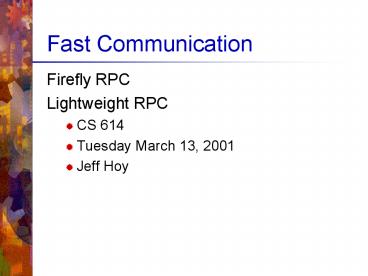Fast Communication - PowerPoint PPT Presentation
1 / 42
Title:
Fast Communication
Description:
Fast Communication Firefly RPC Lightweight RPC CS 614 Tuesday March 13, 2001 Jeff Hoy Why Remote Procedure Call? Simplify building distributed systems and ... – PowerPoint PPT presentation
Number of Views:43
Avg rating:3.0/5.0
Title: Fast Communication
1
Fast Communication
- Firefly RPC
- Lightweight RPC
- CS 614
- Tuesday March 13, 2001
- Jeff Hoy
2
Why Remote Procedure Call?
- Simplify building distributed systems and
applications - Looks like local procedure call
- Transparent to user
- Balance between semantics and efficiency
- Universal programming tool
- Secure inter-process communication
3
RPC Model
Client Application
Server Application
Return
Client Stub
Server Stub
Client Runtime
Server Runtime
Network
Call
4
RPC In Modern Computing
- CORBA and Internet Inter-ORB Protocol (IIOP)
- Each CORBA server object exposes a set of methods
- DCOM and Object RPC
- Built on top of RPC
- Java and Java Remote Method Protocol (JRMP)
- Interface exposes a set of methods
- XML-RPC, SOAP
- RPC over HTTP and XML
5
Goals
- Firefly RPC
- Inter-machine Communication
- Maintain Security and Functionality
- Speed
- Lightweight RPC
- Intra-machine Communication
- Maintain Security and Functionality
- Speed
6
Firefly RPC
- Hardware
- DEC Firefly multiprocessor
- 1 to 5 MicroVAX CPUs per node
- Concurrency considerations
- 10 megabit Ethernet
- Takes advantage of 5 CPUs
7
Fast Path in a RPC
- Transport Mechanisms
- IP / UDP
- DECNet byte stream
- Shared Memory (intra-machine only)
- Determined at bind time
- Inside transport procedures Starter,
Transporter, Ender, and Receiver for the
server
8
Caller Stub
- Gets control from calling program
- Calls Starter for packet buffer
- Copies arguments into the buffer
- Calls Transporter and waits for reply
- Copies result data onto callers result variables
- Calls Ender and frees result packet
9
Server Stub
- Receives incoming packet
- Copies data into stack, a new data block, or left
in the packet - Calls server procedure
- Copies result into the call packet and transmit
10
Transport Mechanism
- Transporter procedure
- Completes RPC header
- Calls Sender to complete UDP, IP, and Ethernet
headers (Ethernet is the chosen means of
communication) - Invoke Ethernet driver via kernel trap and queue
the packet
11
Transport Mechanism
- Receiver procedure
- Server thread awakens in Receiver
- Receiver calls the stub interface included in
the received packet, and the interface stub calls
the procedure stub - Reply is similar
12
Threading
- Client Application creates RPC thread
- Server Application creates call thread
- Threads operate in server applications address
space - No need to spawn entire process
- Threads need to consider locking resources
13
Threading
14
Performance Enchancements
- Over traditional RPC
- Stubs marshal arguments rather than library
functions handling arguments - RPC procedures called through procedure variables
rather than by lookup table - Server retains call packet for results
- Buffers reside in shared memory
- Sacrifices abstract structure
15
Performance Analysis
- Null() Procedure
- No arguments or return value
- Measures base latency of RPC mechanism
- Multi-threaded caller and server
16
Time for 10,000 RPCs
- Base latency 2.66ms
- MaxResult latency (1500 bytes) 6.35ms
17
Send and Receive Latency
18
Send and Receive Latency
- With larger packets, transmission time dominates
- Overhead becomes less of an issue
- Good for Firefly RPC, assuming large transmission
over network - Is overhead acceptable for intra-machine
communication?
19
Stub Latency
- Significant overhead for small packets
20
Fewer Processors
- Seconds for 1,000 Null() calls
21
Fewer Processors
- Why the slowdown with one processor?
- Fast path can be followed only in multiprocessor
environment - Lock conflicts, scheduling problems
- Why little speedup past two processors?
22
Future Improvements
- Hardware
- Faster network will help larger packets
- Triple CPU speed will reduce Null() time by 52
and MaxResult by 36 - Software
- Omit IP and UDP headers for Ethernet datagrams,
24 gain - Redesign RPC protocol 5 gain
- Busy thread wait, 1015 gain
- Write more in assembler, 510 gain
23
Other Improvements
- Firefly RPC handles intra-machine communication
through the same mechanisms as inter-machine
communication - Firefly RPC also has very high overhead for small
packets - Does this matter?
24
RPC Size Distribution
- Majority of RPC transfers under 200 bytes
25
Frequency of Remote Activity
- Most calls are to the same machine
26
Traditional RPC
- Most calls are small messages that take place
between domains of the same machine - Traditional RPC contains unnecessary overhead,
like - Scheduling
- Copying
- Access validation
27
Lightweight RPC (LRPC)
- Also written for the DEC Firefly system
- Mechanism for communication between different
protection domains on the same system - Significant performance improvements over
traditional RPC
28
Overhead Analysis
- Theoretical minimum to invoke Null() across
domains kernal trap context change to call and
a trap context change to return - Theoretical minimum on Firefly RPC 109 us.
- Actual cost 464us
29
Sources of Overhead
- 355us added
- Stub overhead
- Message buffer overhead
- Not so much in Firefly RPC
- Message transfer and flow control
- Scheduling and abstract threads
- Context Switch
30
Implementation of LRPC
- Similar to RPC
- Call to server is done through kernel trap
- Kernel validates the caller
- Servers export interfaces
- Clients bind to server interfaces before making a
call
31
Binding
- Servers export interfaces through a clerk
- The clerk registers the interface
- Clients bind to the interface through a call to
the kernel - Server replies with an entry address and size of
its A-stack - Client gets a Binding Object from the kernel
32
Calling
- Each procedure is represented by a stub
- Client makes a call through the stub
- Manages A-stacks
- Traps to the kernel
- Kernel switches context to the server
- Server returns by its own stub
- No verification needed
33
Stub Generation
- Procedure representation
- Call stub for client
- Entry stub for server
- LRPC merges protocol layers
- Stub generator creates run-time stubs in assembly
language - Portability sacrificed for Performance
- Falls back on Modula2 for complex calls
34
Multiple Processors
- LRPC caches domains on idle processors
- Kernel checks for an idling processor in the
server domain - If a processor is found, caller thread can
execute on the idle processor without switching
context
35
Argument Copying
- Traditional RPC copies arguments four times for
intra-machine calls - Client stub to RPC message to kernels message to
servers message to servers stack - In many cases, LRPC needs to copy the arguments
only once - Client stub to A-stack
36
Performance Analysis
- LRPC is roughly three times faster than
traditional RPC - Null() LRPC cost 157us, close to the 109us
theoretical minimum - Additional overhead from stub generation and
kernel execution
37
Single-Processor Null() LRPC
38
Performance Comparison
- LRPC versus traditional RPC (in us)
39
Multiprocessor Speedup
40
Inter-machine Communication
- LRPC is best for messages between domains on the
on the same machine - The first instruction of the LRPC stub checks if
the call is cross-machine - If so, stub branches to conventional RPC
- Larger messages are handled well, LRPC scales by
packet size linearly like traditional RPC
41
Cost
- LRPC avoids needless scheduling, copying, and
locking by integrating the client, kernel,
server, and message protocols - Abstraction is sacrificed for functionality
- RPC is built into operating systems (Linux DCE
RPC, MS RPC)
42
Conclusion
- Firefly RPC is fast compared to most RPC
implementations. LRPC is even faster. Are they
fast enough? - The performance of Firefly RPC is now good
enough that programmers accept it as the standard
way to communicate (1990) - Is speed still an issue?































